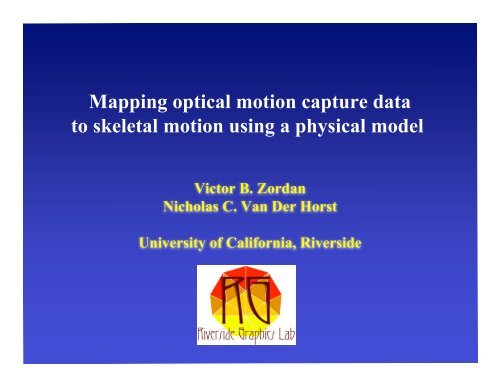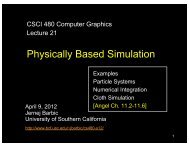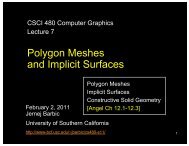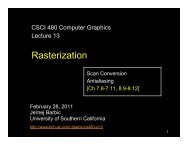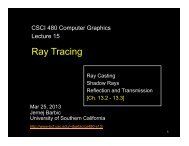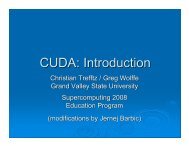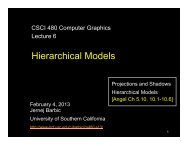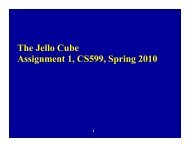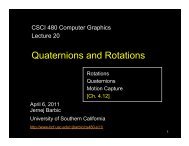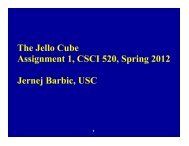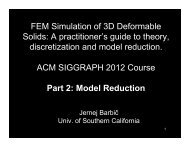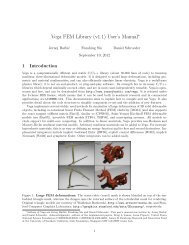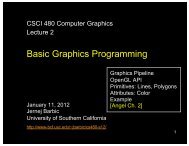Mapping optical motion capture data to skeletal motion using a ...
Mapping optical motion capture data to skeletal motion using a ...
Mapping optical motion capture data to skeletal motion using a ...
Create successful ePaper yourself
Turn your PDF publications into a flip-book with our unique Google optimized e-Paper software.
<strong>Mapping</strong> <strong>optical</strong> <strong>motion</strong> <strong>capture</strong> <strong>data</strong><br />
<strong>to</strong> <strong>skeletal</strong> <strong>motion</strong> <strong>using</strong> a physical model<br />
Vic<strong>to</strong>r B. Zordan<br />
Nicholas C. Van Der Horst<br />
University of California, Riverside
Motivation
Motivation<br />
Optical <strong>data</strong> + Skele<strong>to</strong>n Posture<br />
Problems: no perfect match, joint-center and rigid-body assumptions,<br />
limits on ranges of <strong>motion</strong>, aesthetic and production requirements
Motivation<br />
Isn't this problem solved by inverse kinematics (IK)<br />
in commercial solvers?<br />
Data is becoming more available (e.g. CMU mocap site)<br />
BUT you want <strong>to</strong> map it <strong>to</strong> our own character<br />
Money... Filmbox is expensive!<br />
IK vs. our physical modeling approach<br />
Direct mapping of <strong>data</strong> - landmark for landmark<br />
Whole body solution - root gets no special priority<br />
Easily avoids singularities - straight limbs not a problem<br />
Avoids footskate - via ground contact reaction forces
Motivation<br />
Recorded <strong>data</strong> is becoming more available (e.g. CMU site)<br />
but we want <strong>to</strong> map it <strong>to</strong> our own character<br />
Commercial packages exist (like Kaydara's filmbox<br />
and Vicon's Motionbuilder) but they are expensive<br />
Also, their solution is based on inverse kinematics (IK)<br />
which has known problems that lead <strong>to</strong> noticable flaws:<br />
1) Ill-defined singularities yielding limbs that do not<br />
become fully straight<br />
2) Indirect, root-centric mapping leading <strong>to</strong> errors<br />
that propogate, e.g. footskate<br />
3) Redundancies corrected by adhoc heuristics ca<strong>using</strong><br />
various quirk artifacts
Background<br />
Motion <strong>capture</strong> editing<br />
Too many <strong>to</strong> mention, see mocap session SIGGRAPH ’02<br />
<strong>Mapping</strong> <strong>to</strong> skele<strong>to</strong>ns<br />
Silaghi, Plankers, Fua, Boulic, Fua, Thalmann ’98<br />
Molet, Boulic, Thalmann ’99<br />
Monzani, Baerlocher, Boulic, Thalmann ’00<br />
O`Brien, Bodenheimer, Bros<strong>to</strong>w, Hodgins ’00<br />
Ude, Mann, Riley, Atkeson ’00<br />
Pollard, Hodgins, Riley, Atkeson ’02<br />
Kovar, Schreiner, Gleicher '02<br />
Physics and <strong>motion</strong> <strong>capture</strong><br />
Rose, Guenter, Bodenheimer, Rose ’96<br />
Popovic & Witkin ’99<br />
Pollard ’99, Pollard & Behmaram-Mosavat ’00<br />
Zordan & Hodgins ’02
Approach overview<br />
Simulation is used offline<br />
<strong>to</strong> compute postures<br />
Internal <strong>to</strong>rque actua<strong>to</strong>rs<br />
allow the simulation <strong>to</strong> act<br />
as a flexible ragdoll<br />
Force springs pull 'ragdoll'<br />
<strong>to</strong> reach the <strong>data</strong>, marker<br />
by marker<br />
Contact (e.g. ground) may<br />
be added through force
Approach overview<br />
Basic Algorithm<br />
foreach (<strong>data</strong> sample) {<br />
update [yellow] markers<br />
while (not still) {<br />
compute <strong>to</strong>rques<br />
compute body forces<br />
if (active)<br />
compute contact forces<br />
update simulation<br />
}//while<br />
record posture<br />
}//for
Internal <strong>to</strong>rque control<br />
PD-servo's control 3D ball joints at each<br />
articulation point <strong>to</strong> resist bending<br />
τ<br />
τ= k( θ d – θ ) – b( θ )<br />
θ d from rest position<br />
k and b are stiffness<br />
and damping, inertial<br />
scaled (Zordan & Hodgins '02)<br />
No joint limits
Additional body forces<br />
Force-driven virtual 'landmarks' placed by hand<br />
guide the simulated bodies <strong>to</strong> follow the markers<br />
Fmarker<br />
Fdamping<br />
τ<br />
Springs pull the simulation <strong>to</strong><br />
the marker <strong>data</strong><br />
Fmarker = -kf Xerror<br />
Body <strong>motion</strong> is damped<br />
Fdamping = -bf Vbody<br />
Note, markers near joints affect<br />
both nearby bodies
Additional constraint forces<br />
Avoiding foot/ground penetration and foot skate<br />
Normal ground forces<br />
flatten the foot on ground<br />
via a penalty method<br />
Marker <strong>data</strong> is used <strong>to</strong><br />
tag when each foot is<br />
sliding or not<br />
Horizontal friction forces<br />
(not shown) resist in<br />
opposite direction of<br />
the simulated point<br />
velocity when in slip
Implementation details & examples<br />
39 Degrees of freedom - simulated in ODE (free!)<br />
Runs about 2-3 frames/sec on 2.4 GHz Pentium IV<br />
4 tuned parameters - <strong>to</strong>rque stiffness & damping<br />
marker spring stiffness<br />
body force damping<br />
(plus, ground contact model)
Posture error
Raw vs sim foot position
Conclusion/future work<br />
Simple, easy <strong>to</strong> implement, and inexpensive<br />
Would dovetail nicely with a skele<strong>to</strong>n estima<strong>to</strong>r<br />
Likely requires a two-pass process for <strong>motion</strong><br />
severe character retargeting<br />
Would benefit from a specialized marker set<br />
(markers spread over body parts with<br />
highly repeatable landmarks, for example)<br />
Should run interactively, <strong>to</strong> be used during the<br />
live <strong>motion</strong> <strong>capture</strong>e shoot
www.cs.ucr.edu/~rgl<br />
Thank you!


